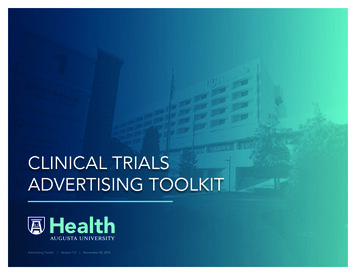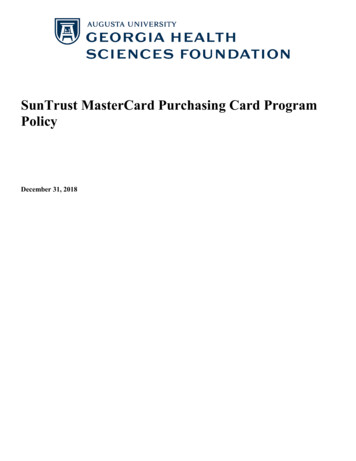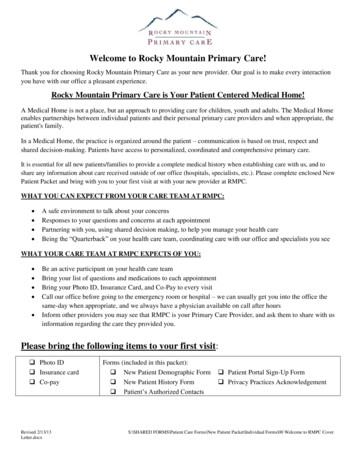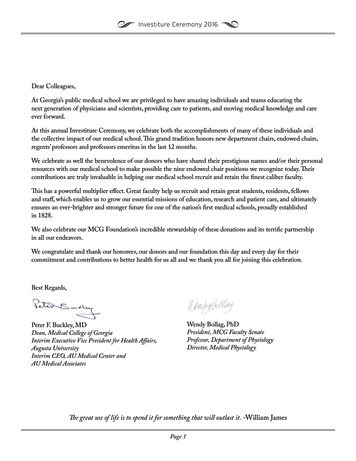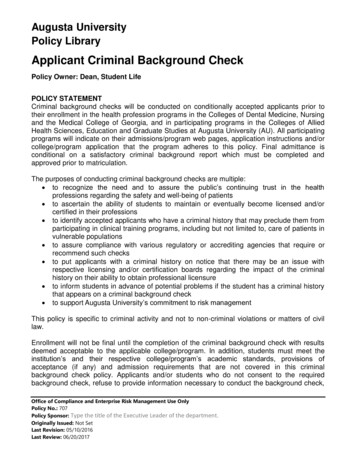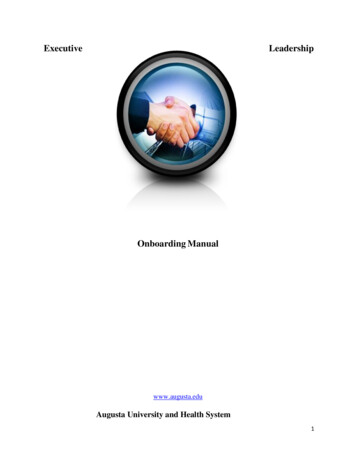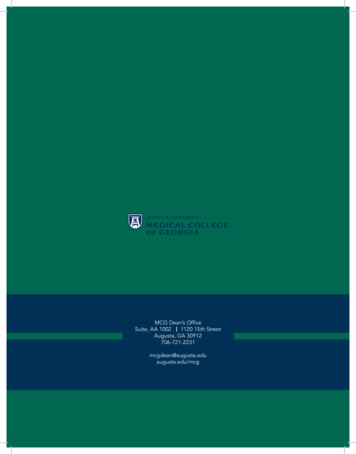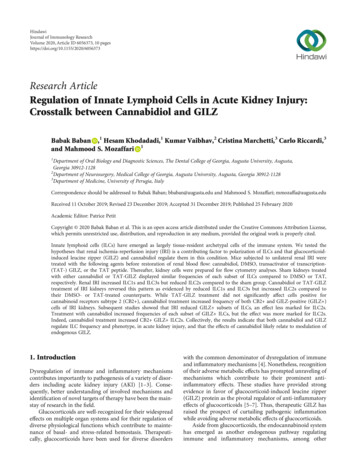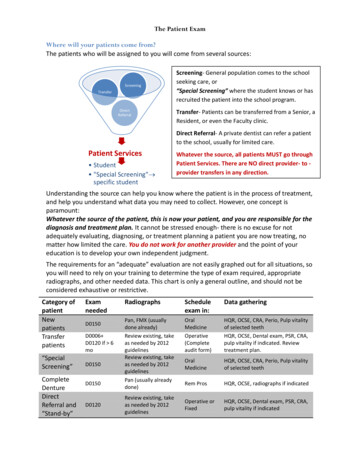
Transcription
The Patient ExamWhere will your patients come from?The patients who will be assigned to you will come from several sources:ScreeningTransferDirectReferralScreening- General population comes to the schoolseeking care, or“Special Screening” where the student knows or hasrecruited the patient into the school program.Transfer- Patients can be transferred from a Senior, aResident, or even the Faculty clinic.Direct Referral- A private dentist can refer a patientto the school, usually for limited care.Patient Services Student "Special Screening" specific studentWhatever the source, all patients MUST go throughPatient Services. There are NO direct provider- to provider transfers in any direction.Understanding the source can help you know where the patient is in the process of treatment,and help you understand what data you may need to collect. However, one concept isparamount:Whatever the source of the patient, this is now your patient, and you are responsible for thediagnosis and treatment plan. It cannot be stressed enough- there is no excuse for notadequately evaluating, diagnosing, or treatment planning a patient you are now treating, nomatter how limited the care. You do not work for another provider and the point of youreducation is to develop your own independent judgment.The requirements for an “adequate” evaluation are not easily graphed out for all situations, soyou will need to rely on your training to determine the type of exam required, appropriateradiographs, and other needed data. This chart is only a general outline, and should not beconsidered exhaustive or restrictive.Category ening”CompleteDentureDirectReferral and“Stand-by”ExamneededD0150D0006 D0120 if 6moD0150D0150D0120RadiographsScheduleexam in:Data gatheringPan, FMX (usuallydone already)Review existing, takeas needed by 2012guidelinesReview existing, takeas needed by 2012guidelinesPan (usually alreadydone)OralMedicineOperative(Completeaudit form)HQR, OCSE, CRA, Perio, Pulp vitalityof selected teethHQR, OCSE, Dental exam, PSR, CRA,pulp vitality if indicated. Reviewtreatment plan.OralMedicineHQR, OCSE, CRA, Perio, Pulp vitalityof selected teethRem ProsHQR, OCSE, radiographs if indicatedOperative orFixedHQR, OCSE, Dental exam, PSR, CRA,pulp vitality if indicatedReview existing, takeas needed by 2012guidelines
Radiographs:New Patients: Each patient will already have undergone a panoramic and full mouth series ofradiographs.All other patients, you need to use your judgment on which radiographs to take and how often.Type of encounterPeriodontal DiseaseCaries RiskNew patientAdolescent with permanentrddentition (prior to 3 molareruption)Adult, dentate or partiallydentateIndividualized radiographic exam consisting of: Posterior bitewings with panoramic exam or Posterior bitewings and selected periapical images.A full mouth intraoral radiographic exam is preferredwhen the patient has clinical evidence of generalized oraldisease or a history of extensive dental treatmentAdult, edentulousIndividualizedradiographic exam,based on clinicalsigns and symptomsRecall Patient* withclinical caries or atincreased risk forcaries**Posterior bitewing exam at6-12 month intervals ifproximal surfaces cannot beexamined visually or with aprobePosterior bitewing examat 6-18 month intervalsNot applicableRecall Patient* with noclinical caries and not atincreased risk forcaries**Posterior bitewing exam at18-36 month intervalsPosterior bitewing examat 24-36 month intervalsNot applicableRecall Patient* withperiodontal diseaseClinical judgment as to the need for and type ofradiographic images for the evaluation of periodontaldisease. Imaging may consist of, but is not limited to,selected bitewing and/or periapical images of areaswhere periodontal disease (other than nonspecificgingivitis) can be demonstrated clinically.Patient with othercircumstances such as:implants, pathoses,restorative/ endodonticneeds, treatedperiodontal disease andcaries remineralizationNot applicableClinical judgment as to need for and type of radiographic images for evaluation and/ormonitoring of these conditions*Clinical situations for which radiographs are indicated such as:A. Positive Historical Findings: Previous periodontal or endodontic treatment, History of pain or trauma, Familial history of dentalanomalies, Postoperative evaluation of healing, Remineralization monitoring, Presence of implants, previous implant-related pathosisor evaluation for implant placementB. Positive Clinical Signs/Symptoms: Clinical evidence of periodontal disease, Large or deep restorations, Deep carious lesions,Malposed or clinically impacted teeth, Swelling, Evidence of dental/facial trauma, Mobility of teeth, Sinus tract (“fistula”), Clinicallysuspected sinus pathosis, Growth abnormalities, Oral involvement in known or suspected systemic disease, Positive neurologicfindings in the head and neck, Evidence of foreign objects, Pain and/or dysfunction of the temporomandibular joint, Facialasymmetry, Abutment teeth for fixed or removable partial prosthesis, Unexplained bleeding, Unexplained sensitivity of teeth,Unusual eruption, spacing or migration of teeth, Unusual tooth morphology, calcification or color, Unexplained absence of teeth,Clinical tooth erosion, Peri-implantitis**Factors increasing risk for caries may be assessed using the Caries Risk Assessment forms
Complete Radiographic Interpretation: Complete the Radiographic Interpretation tab in axiUm to the best of your ability, thenschedule to meet with a designated Radiology (or a designated ORehab faculty member onoccasion) to evaluate your work (this process is graded pass/fail). They will be askingquestions on evaluating the quality of the radiograph (positioning errors) and normal anatomicstructures as well as dental anatomy and pathosis like caries. After doing four radiographic interpretations with a passing grade, you will do a Competencycase in the spring. If you pass, you will continue to complete the Radiology Tab in axiUm, butyou can choose to schedule with Radiology or as part of your DXR appt.The Exam Process: Comprehensive Oral Exam D0150, Periodic exam (D0120), or a D0006 (SDM codefor a chart review): This is a general overview of the process for a new patient. See below forspecific checklists. The blue boxes are linked to additional helpful information.1. Chief Concerns: Concise summary of concerns (complaints)in patient’s own words. If the patient is in pain, see Phase 1Relieve Pain for diagnostic information.2. Health History: Either new patient record or a review ofexisting records. Print out a hard copy of the Medical HistoryChecklist so you can sit face to face with the patient and takenotes on it.For specific problems, look up the correct guidelineinformation and see what you need to follow up and learn.Check the medications the patient is on to see if theindications for the medications match the disease.Additional information is linked inside some of theguidelines.Medication reconciliation. For each medication the patientis taking, ask what the medication is prescribed for, andmake sure that problem is on the patient’s medical history.List the medication class and any dental implications it mayhave.Examples: Effects on salivary flow, taste changes,interactions with other commonly dentally prescribed drugs(antibiotics, pain meds, anesthetics), implications withcommon dental procedures (bleeding, block anesthesia,surgical procedures).3. Head and Neck Exam, include Oral Cancer Screening Exam.For detailed checklist, click on this link:4. Dental Exam:1. Missing and Impacted Teeth2. Conditions3. Materials4. Decay5. Caries Risk Assessment: Based on radiograph and exam,complete CRA form in axiUm. Click on the link for additionalinformation.6. Periodontal Charting: Note pocket depths and PlaqueIndices, unless calculus is too heavy for accuracy.7. Study Casts: Make impressions so that you can fabricate aset of study casts.Medical History ChecklistAdrenal GuidelinesAnticoagulation GuidelinesAsthma GuidelinesDiabetes GuidelinesHypertension GuidelinesInfective EndocarditisGuidelinesHIV GuidelinesHead and Neck Exam ChecklistCheat Sheet of Charting SymbolsCaries Risk AssessmentPeriodontal Charting ReferenceStudy Cast Checklist
A. Comprehensive Oral Evaluation- New or Established Patient (D0150).Of course use this code when you have a new patient, however if your established patient has not beenseen for more than three years you use this code. It is a thorough evaluation of the patient’s medicalcondition, oral condition including charting, evaluation of occlusion, periodontal evaluation, and ofcourse, an oral cancer screening exam with recording of any finding. For this type of exam, follow the whole sequence 1-7 above.B. Periodic Oral Evaluation- Established Patient (D0120) AKA “Recall exam” “Annual exam”This type of exam is done on a patient who already has a chart in the SDM (a “patient of record”) thathas been seen within 3 years (otherwise they would need a D0150) but has not had a D0120 within thepast 6 months. You are examining them to determine if there are any changes in their dental or medicalhealth status since their last evaluation (not treatment appointment!). This involves: Review Medical History. Every question needs a yes or no answer. Cool axiUm trick: If theresponse is the same as last notation, click “Control R” to automatically update to today’s date.Vital signs. Remember BP assessment questions, confirm with faculty.Complete treatment modifications and summary statements (See student forms for templates)Head and Neck ExamEvaluate for Oral Medicine Consult:o Is pt an ASA III?o Have they had a change in ASA status for the worse?o Had a significant change in health history: hospitalization, surgery, or new systemicdisease diagnosis?o Had a significant change in medications?o Have a new oral mucosal lesion noted on Head and Neck exam?Dental ExamCaries Risk AssessmentRadiographic Interpretation. Review most recent films- are new films indicated based onfindings of dental exam (see above)? If so, take radiographs and complete a radiographicinterpretation form based on those films.PSR. Has the patient been medically cleared to do probing depths? If so, take the PSR readings.Is a perio consultation needed?PSR BasicsB. Chart Audit (D0006) This is not an ADA code. It is a way for us to keep track of the patient’s care in acomplex system. Usually this is done when a patient is transferred from one student to another, whenwe need to stop, review the chart formally, and rethink where we are with the patient. If the patientalso needs a D0120 exam because it has been 6 months since their last exam, then certainly chart aD0120 as well.Checklist: D0006 Information PDFReview Medical History. Every question needs a yes or no answer. Use “Control R” if responseunchanged.Vital signs. Remember BP assessment questions, confirm with faculty.Complete treatment modifications and summary statements (See student forms for templates)Head and Neck ExamEvaluate for Oral Medicine Consult:o Is pt an ASA III?o Have they had a change in ASA status for the worse?o Had a significant change in health history: hospitalization, surgery, or new systemicdisease diagnosis?
o Had a significant change in medications?o Have a new oral mucosal lesion noted on Head and Neck exam?Dental ExamCaries Risk AssessmentRadiographic Interpretation. Review most recent films- are new films indicated based onfindings of dental exam (see above)? If so, take radiographs and complete a radiographicinterpretation form based on those films.Review progression of Treatment Plan. Check existing treatment plans. If treatment has notbeen completed, find out why not. Check the “in-Progress” tab and note any outstandingtreatment. If completed, have your faculty member delete it.Develop a new Treatment Plan.o Are there any Occlusal Plane Discrepancies that may impact the Phase 3 TreatmentPlan?Study Casts. Evaluate hand-articulated casts- are they accurate? If not, make new impressionsPSR. Has the patient been medically cleared to do probing depths? If the patient has hadperiodontal charting done within the past year, do a PSR. Is a perio consultation needed?
HQR, OCSE, Dental exam, PSR, CRA, pulp vitality if indicated. Review treatment plan. "Special Screening" D0150 Review existing, take as needed by 2012 guidelines Oral Medicine HQR, OCSE, CRA, Perio, Pulp vitality of selected teeth Complete Denture D0150 Pan (usually already done) Rem Pros HQR, OCSE, radiographs if indicated Direct Referral and

